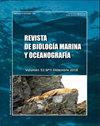奇帕纳湾(21°20'S)不同海洋条件下浮游细菌丰度和大小结构的响应
IF 0.5
4区 生物学
Q4 MARINE & FRESHWATER BIOLOGY
引用次数: 3
摘要
西班牙通过基于细胞丰度和大小的近似方法,分析了智利北部上升区浮游细菌与海洋学条件之间的关系。研究区域是巴伊亚·奇帕纳(21°20'),分析了2004-2006年的夏季和2005-2007年的冬季。温度、盐度和氧气通过CTD记录,浮游细菌和叶绿素-A样本在标准深度获得。水柱物理结构的变异性与最小氧气区和El Nino-La Nina事件影响下的上升事件有关。浮游细菌丰度最高的是2004年12月和2005年7月,分别与沿海边缘有关(1.07×10(9)-5.12×10(9)Cel L-1和1.44×10(9)Cel L-1)。2006年和2007年,在最远离海岸的站点的海岸边缘和表层发现了较低的丰度,其值分别在6.77×10(7)-3.67×10(9)cel L-1之间波动。使用广义的加性模型可以确定盐度、水柱稳定性和浮游植物生物量对原核生物丰度有显著影响。较高的细胞体积与较低的丰度有关,主要大小结构为0.4-0.8和0.8-1.2µm长。这项研究表明,浮游细菌的丰度和细胞大小发生了时间变化,这些变化与物理因素有关,主要是盐度和水柱的稳定性。在厄尔尼诺-拉尼娜事件之间观察到的过渡会导致水柱发生变化,这与温跃层的加深有关,温跃层的扩大和收缩最终可能影响浮游细菌的生产能力。在两个对比季节,分析了智利北部上升区细菌浮游生物与海洋学条件之间的关系,强调了一种基于丰度和大小结构的方法。研究区域是Chipana湾(21°20'),分析了2004-2006年的夏季和2005-2007年的冬季。用CTD记录温度、盐度和氧气,并在标准深度下获得细菌浮游生物和叶绿素-A样本。在最小氧气区和El Nino-La Nina事件的影响下,水柱物理结构的变化与上升有关。2004年12月和2005年7月观察到细菌浮游生物丰度最高,(分别为1.07×10(9)-5.12×10(9)L-1细胞和1.44×10(9)L-1细胞),与海岸边缘和远离海岸的地表水有关。2006年和2007年,在沿海边缘和海洋站表层发现了较低的丰度,数值分别在6.77×10(7)-3.67×10(9)个L-1细胞之间波动。通用添加剂模型的使用确定了最佳预测因子是盐度、溶解氧和总叶绿素。与低丰度相关的较高细胞体积,在长度上为0.4-0.8和0.8-1.2µm的主导结构。这项研究表明,细菌浮游生物的丰度和细胞大小发生了与物理因素有关的时间变化,主要是水柱的盐度和稳定性。观察到的厄尔尼诺和拉尼娜之间的过渡导致与温跃层加深有关的水柱发生变化,温跃层扩大和收缩了世卫组织,最终可能影响细菌浮游生物的生产能力。本文章由计算机程序翻译,如有差异,请以英文原文为准。
Respuesta de la abundancia y estructura de tamaño del bacterioplancton a diferentes condiciones oceanográficas en bahía Chipana (21°20'S)
espanolSe analizo la relacion entre el bacterioplancton y las condiciones oceanograficas en un area de surgencia en el norte de Chile, mediante aproximacion basada en las abundancias y tamanos celulares. El area de estudio fue bahia Chipana (21°20'S), se analizaron los veranos del 2004-2006 y los inviernos 2005-2007. La temperatura, salinidad y oxigeno se registraron mediante un CTD, las muestras de bacterioplancton y clorofila-a fueron obtenidas a profundidades estandares. La variabilidad de la estructura fisica de la columna de agua se asocio a eventos de surgencia, bajo la influencia de la zona de minimos de oxigeno y eventos El Nino-La Nina. La mayor abundancia del bacterioplancton se observo en diciembre 2004 y julio 2005, asociadas al margen costero (1,07×10(9)-5,12×10(9) cel L-1 y 1,44×10(9) cel L-1, respectivamente). Para el 2006 y 2007, se detecto una menor abundancia en el margen costero y en la capa superficial de las estaciones mas alejadas de la costa, los valores fluctuaron entre 6,77×10(7)-3,67×10(9) cel L-1, respectivamente. El uso de modelos aditivos generalizados, permitio determinar que la salinidad, estabilidad de la columna de agua y biomasa del fitoplancton tuvieron un efecto significativo sobre la abundancia procariota. Los mayores volumenes celulares se asociaron a las menores abundancias, siendo la estructura de tamano dominante 0,4-0,8 y 0,8-1,2 µm de longitud. Este estudio sugiere que la abundancia y el tamano celular del bacterioplancton sufren variaciones temporales que se relacionan a factores fisicos, principalmente la salinidad y estabilidad de la columna de agua. La transicion observada entre eventos El Nino-La Nina genera cambios en la columna de agua asociados a una profundizacion de la termoclina, que expande y contrae la OMZ, que finalmente podrian afectar la capacidad productiva del bacterioplancton. EnglishThe relationship between bacterioplankton and oceanographic conditions of an upwelling area of northern Chile was analyzed, during two contrasting seasons, emphasizing an approach based in the abundance and size structure. The study area was Chipana Bay (21°20'S), and analyzed the summers of 2004-2006 and winters of 2005-2007. The temperature, salinity and oxygen were recorded with a CTD and the bacterioplankton and chlorophyll-a samples were obtained at standards depths. The variability of the physical structure of the water column was associated with upwelling, under the influence of the oxygen minimum zone and El Nino-La Nina events. The higher abundance of bacterioplankton was observed in December 2004 and July 2005, (1.07×10(9)-5.12×10(9) cell L-1 and 1.44×10(9) cell L-1, respectively), associated with coastal margin and surface water away from the coast. For 2006 and 2007, a lower abundance was detected in the coastal margin and in the surface layer of the offshore stations, the values fluctuated between 6.77 × 10(7)-3.67 × 10(9) cells L-1, respectively. The use of generalized additive models determined that the best predictors were salinity, dissolved oxygen and the total chlorophyll. The higher cell volumes associated with low abundance, being the dominant structure size 0.4-0.8 and 0.8-1.2 µm in length. This study suggests that the abundance and cellular size of bacterioplankton undergo temporal variations that are related to physical factors, mainly salinity and stability of the water column. The observed transition between El Nino and La Nina causes changes in the water column associated with a deepening of the thermocline, which expands and contracts the OMZ, which could eventually affect the productive capacity of the bacterioplankton.
求助全文
通过发布文献求助,成功后即可免费获取论文全文。
去求助
来源期刊
CiteScore
0.70
自引率
0.00%
发文量
41
审稿时长
12 months
期刊介绍:
Publicar desde una perspectiva científica, artículos originales, decididos por un proceso de revisión por pares, invitando a expertos de reconocido prestigio en el área. Los trabajos publicados se caracterizarán por su solidez teórica-metodológica, actualidad y relevancia para las ciencias marinas.
Se reciben trabajos inéditos derivados de la investigación científica realizada en ambientes marinos y estuarios, en formato de Revisión, Artículos, Notas Científicas, y Obituarios en las siguientes disciplinas::
Biología-Ecología marina
Oceanografía física, química y biológica
Contaminación marina
Geología marina
Sistemática, Faunística y Biogeografía Marina
Manejo Costero
Acuicultura marina
Pesquería marina.

 求助内容:
求助内容: 应助结果提醒方式:
应助结果提醒方式:


